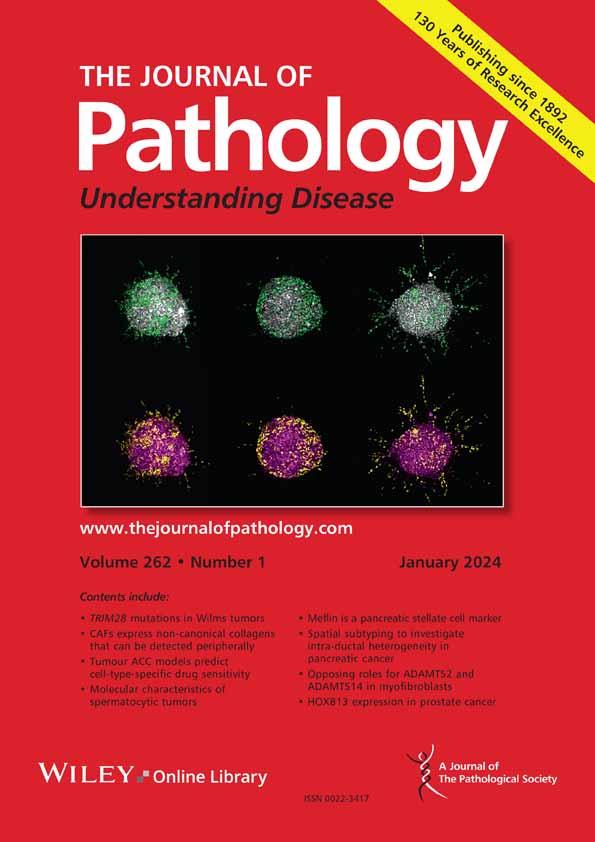Kevin T Jamouss, Alexander Ioannis Damanakis, Abigail C Cornwell, Martine Jongepier, Maria A Trujillo, Michael Johannes Pflüger, Ryan Kawalerski, Alexandre Maalouf, Katsuya Hirose, Shalini Datta, Abigail Sipes, Brian A Pedro, Emma Gudmundsson, Naziheh Assarzadegan, Logan Engle, Robert B Scharpf, Satomi Kawamoto, Elizabeth D Thompson, Laura D Wood
求助PDF
{"title":"肿瘤免疫微环境改变与人导管内乳头状粘液瘤的进展相关。","authors":"Kevin T Jamouss, Alexander Ioannis Damanakis, Abigail C Cornwell, Martine Jongepier, Maria A Trujillo, Michael Johannes Pflüger, Ryan Kawalerski, Alexandre Maalouf, Katsuya Hirose, Shalini Datta, Abigail Sipes, Brian A Pedro, Emma Gudmundsson, Naziheh Assarzadegan, Logan Engle, Robert B Scharpf, Satomi Kawamoto, Elizabeth D Thompson, Laura D Wood","doi":"10.1002/path.6402","DOIUrl":null,"url":null,"abstract":"<p>Pancreatic ductal adenocarcinoma (PDAC) poses a significant challenge due to late-stage diagnoses. To improve patient outcomes, early intervention in precursor lesions such as intraductal papillary mucinous neoplasm (IPMN) is crucial. However, early intervention must be balanced against overtreatment of low-risk lesions that are unlikely to progress, underscoring the need to better understand molecular alterations in neoplastic cells and changes in the tumor microenvironment (TME) that drive the progression of IPMNs. In this study, we characterized alterations in the TME of IPMNs as they progressed to high-grade dysplasia, using immunohistochemistry to quantify immune cell density and activation status in more than 100 well-characterized human IPMN samples. Analyses revealed progression to a more immunosuppressive TME in high-grade IPMN compared with low-grade IPMN, characterized by elevated expression of immune checkpoint molecules (PD-L1, TIM3, VISTA), increased density of macrophages, and decreased density of cytotoxic T cells. Intriguingly, the alterations in macrophages were limited to focal regions of high-grade dysplasia, while T-cell alterations affected the entire IPMN. Additionally, elevated VISTA expression was associated with poorer clinical outcome after IPMN resection in an independent cohort. These findings provide important insights into the interplay between the immune microenvironment and IPMN progression, highlighting potential targets to modify the TME for cancer interception. © 2025 The Pathological Society of Great Britain and Ireland.</p>","PeriodicalId":232,"journal":{"name":"The Journal of Pathology","volume":"266 1","pages":"40-50"},"PeriodicalIF":5.2000,"publicationDate":"2025-02-25","publicationTypes":"Journal Article","fieldsOfStudy":null,"isOpenAccess":false,"openAccessPdf":"","citationCount":"0","resultStr":"{\"title\":\"Tumor immune microenvironment alterations associated with progression in human intraductal papillary mucinous neoplasms\",\"authors\":\"Kevin T Jamouss, Alexander Ioannis Damanakis, Abigail C Cornwell, Martine Jongepier, Maria A Trujillo, Michael Johannes Pflüger, Ryan Kawalerski, Alexandre Maalouf, Katsuya Hirose, Shalini Datta, Abigail Sipes, Brian A Pedro, Emma Gudmundsson, Naziheh Assarzadegan, Logan Engle, Robert B Scharpf, Satomi Kawamoto, Elizabeth D Thompson, Laura D Wood\",\"doi\":\"10.1002/path.6402\",\"DOIUrl\":null,\"url\":null,\"abstract\":\"<p>Pancreatic ductal adenocarcinoma (PDAC) poses a significant challenge due to late-stage diagnoses. To improve patient outcomes, early intervention in precursor lesions such as intraductal papillary mucinous neoplasm (IPMN) is crucial. However, early intervention must be balanced against overtreatment of low-risk lesions that are unlikely to progress, underscoring the need to better understand molecular alterations in neoplastic cells and changes in the tumor microenvironment (TME) that drive the progression of IPMNs. In this study, we characterized alterations in the TME of IPMNs as they progressed to high-grade dysplasia, using immunohistochemistry to quantify immune cell density and activation status in more than 100 well-characterized human IPMN samples. Analyses revealed progression to a more immunosuppressive TME in high-grade IPMN compared with low-grade IPMN, characterized by elevated expression of immune checkpoint molecules (PD-L1, TIM3, VISTA), increased density of macrophages, and decreased density of cytotoxic T cells. Intriguingly, the alterations in macrophages were limited to focal regions of high-grade dysplasia, while T-cell alterations affected the entire IPMN. Additionally, elevated VISTA expression was associated with poorer clinical outcome after IPMN resection in an independent cohort. These findings provide important insights into the interplay between the immune microenvironment and IPMN progression, highlighting potential targets to modify the TME for cancer interception. © 2025 The Pathological Society of Great Britain and Ireland.</p>\",\"PeriodicalId\":232,\"journal\":{\"name\":\"The Journal of Pathology\",\"volume\":\"266 1\",\"pages\":\"40-50\"},\"PeriodicalIF\":5.2000,\"publicationDate\":\"2025-02-25\",\"publicationTypes\":\"Journal Article\",\"fieldsOfStudy\":null,\"isOpenAccess\":false,\"openAccessPdf\":\"\",\"citationCount\":\"0\",\"resultStr\":null,\"platform\":\"Semanticscholar\",\"paperid\":null,\"PeriodicalName\":\"The Journal of Pathology\",\"FirstCategoryId\":\"3\",\"ListUrlMain\":\"https://pathsocjournals.onlinelibrary.wiley.com/doi/10.1002/path.6402\",\"RegionNum\":2,\"RegionCategory\":\"医学\",\"ArticlePicture\":[],\"TitleCN\":null,\"AbstractTextCN\":null,\"PMCID\":null,\"EPubDate\":\"\",\"PubModel\":\"\",\"JCR\":\"Q1\",\"JCRName\":\"ONCOLOGY\",\"Score\":null,\"Total\":0}","platform":"Semanticscholar","paperid":null,"PeriodicalName":"The Journal of Pathology","FirstCategoryId":"3","ListUrlMain":"https://pathsocjournals.onlinelibrary.wiley.com/doi/10.1002/path.6402","RegionNum":2,"RegionCategory":"医学","ArticlePicture":[],"TitleCN":null,"AbstractTextCN":null,"PMCID":null,"EPubDate":"","PubModel":"","JCR":"Q1","JCRName":"ONCOLOGY","Score":null,"Total":0}
引用次数: 0
引用
批量引用





 求助内容:
求助内容: 应助结果提醒方式:
应助结果提醒方式:


